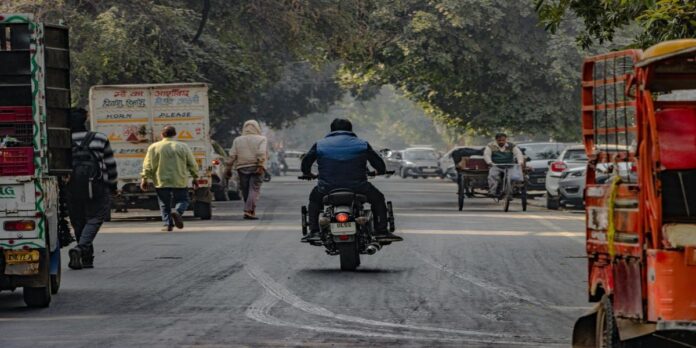At a time when Indian cities are becoming more urbanised, pedestrian safety is a major concern: around 35 percent of traffic deaths in some urban areas involve pedestrians. But the topic receives inadequate government attention.
An average 19 lives are lost to road accidents every hour.
The high incidence of pedestrian fatalities can be attributed to a variety of factors including hazardous driving, risky pedestrian behaviour, insufficient traffic regulations and slack enforcement of those rules.
Inadequate infrastructure is another key contributing factor.
Although hundreds of thousands of pedestrians use India’s city roads daily during peak hours, there’s a widespread lack of adequate pedestrian infrastructure. In particular, motorisation in Indian cities is a relatively recent development, and many cities haven’t yet introduced the required safety infrastructure.
Pedestrian behavior:
Researchers have found the majority of pedestrian-related incidents occur in urban areas, where pedestrian-vehicle interactions are frequent. Many of the fatalities occur close to pedestrian infrastructures such as bus stops, pavements, road overbridges and traffic intersections.
A study in Chennai revealed that pedestrians aged 25 to 34 are most commonly involved in accidents at traffic intersections, mostly due to breaches of right-of-way regulations. That study also found that prevalent risky behaviour among vehicle drivers, such as driving against oncoming traffic, lane changes without due diligence and reckless overtaking, frequently culminated in accidents.
In Kolkata, accident data reveal that pedestrian fatalities at crossings correlate with higher numbers of vehicles, rapid approach speeds and frequent overtaking. These issues are typically exacerbated by cars encroaching onto footpaths due to limited forward visibility and the absence of dedicated pedestrian signals.
Similar risks are associated with the roadway links between intersections, particularly when pedestrians have inadequate crossing options and roads lack distinct markings or sufficient lighting.
Risky intersections:
A study of pedestrian safety in Mumbai, which focused on the hazards pedestrians encounter when they deviate from designated paths while crossing roads, found that abrupt path changes increase the likelihood of accidents.
Extended waiting periods at intersections also exacerbate pedestrian hazards, as these delays may incite irritation and impatience, prompting pedestrians to cross unsafely even when faced with speeding oncoming traffic.
To alleviate traffic congestion at crossings, authorities often construct interchanges where roads are placed at different levels to prevent conflicting traffic movements. These constructions increase vehicle speed, increasing the danger for pedestrians crossing roads.
Pedestrians who rely on public transport also encounter increased difficulty accessing buses because stops are frequently relocated farther from crossings, necessitating longer walking distances.
Jaywalking:
Fenced median strips are used in some areas of the city to deter pedestrians from crossing at hazardous locations. However, pedestrians routinely cross at these locations rather than using adjacent overpasses or underpasses, even in the presence of barriers – a practice popularly called ‘jaywalking’.
Pedestrians often jaywalk because of the physical exertion and inconvenience associated with ascending overpasses or navigating underpasses, particularly when pedestrian facilities are seen as inaccessible or uncomfortable.
Bus stops, particularly those in high-traffic areas or along arterial highways, pose another significant threat to pedestrian safety. Many bus stations are located close to major roads in New Delhi, where heavy traffic makes crossing difficult. These locations are associated with a higher risk of accidents, as pedestrians are required to wait longer to cross.
In Delhi’s peripheral regions, pedestrian infrastructure is still substandard, with many bus stops lacking fundamental amenities such as sidewalks and adequate lighting. Here, pedestrian safety is disproportionately impacted by this lack of infrastructure, particularly in areas that are underserved or have low population density.
Studies demonstrate the accessibility of pedestrian crossings significantly influences their efficacy. Nevertheless, Indian cities persist with constructing pedestrian bridges and underpasses to facilitate pedestrian crossings, despite research indicating their limited use owing to inconvenience.
What could help?
Unfortunately, several Indian cities allocate funds to substantial infrastructure projects that do little to improve pedestrian safety. Too frequently, these cities disregard the requirements of public transport users and pedestrians.
Safety interventions, including rumble strips and speed bumps, can lower vehicle speeds and boost pedestrian safety, especially on thoroughfares with regular pedestrian crossings.
What’s more, minor roundabouts can efficiently reduce traffic speed without a significant price tag.
Studies suggest pedestrian crossings should prioritise convenience to promote their use and decrease the urge for pedestrians to cross at hazardous locations.
A comprehensive approach to intersection design that accounts for pedestrian density, crossing demand and visibility is also crucial for improving pedestrian safety.
Investing in non-motorised transport and public transportation infrastructure will enable Indian cities to diminish their dependence on personal motor vehicles, lower fuel consumption and reduce CO2 emissions.
About author:Shalini Rankavat is an Associate Professor at the School of Engineering, Shiv Nadar University in Greater Noida, Uttar Pradesh, India. Her research interests are in travel behaviour analysis, non-motorised transport planning, transit-oriented development, data-driven traffic management, public transit demand and pedestrian safety.
Originally published under Creative Commons by 360info™.






In-depth research…!